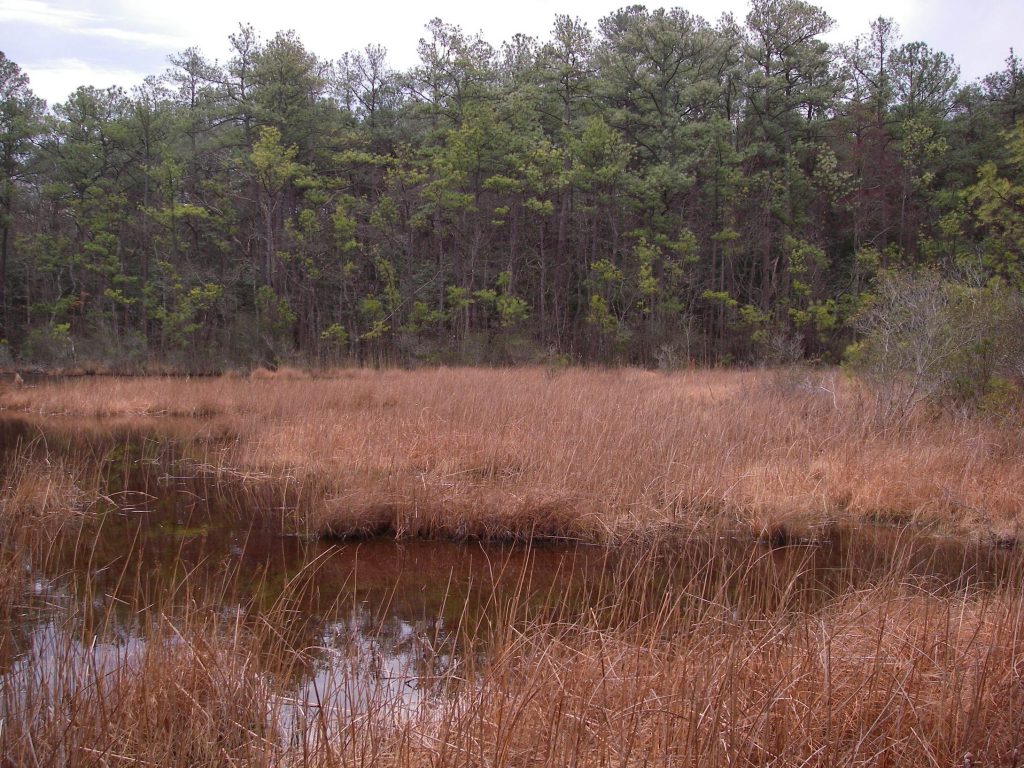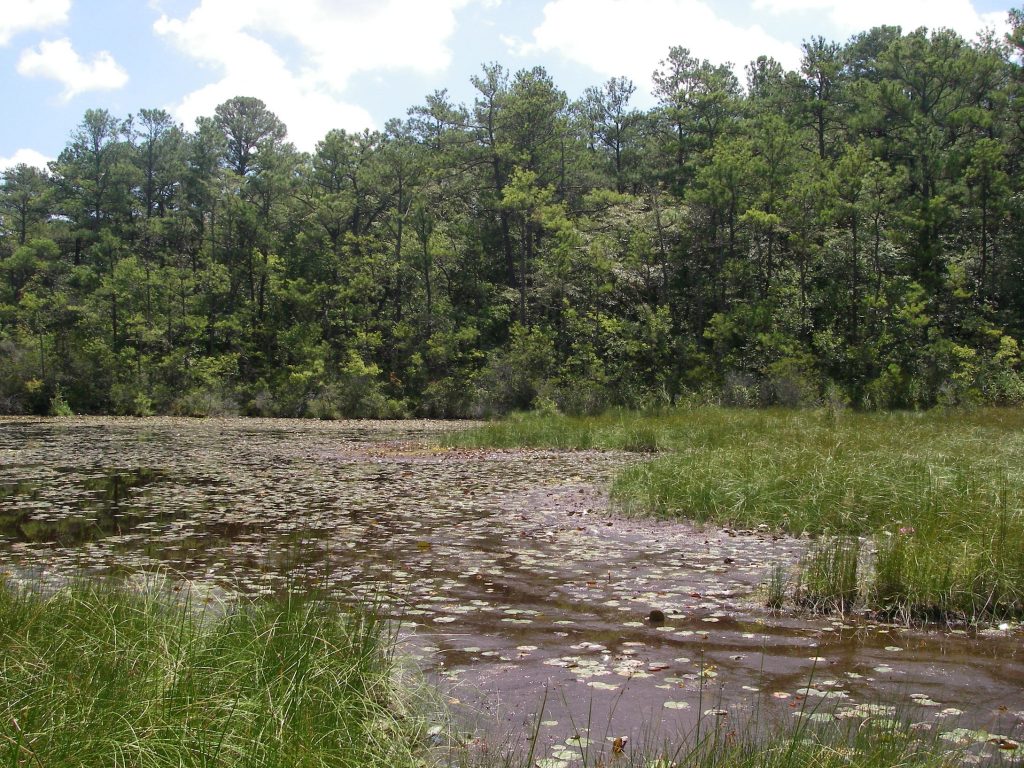
Facebook Twitter Instagram YouTube
Written on: December 19th, 2022 in Education and Outreach
By Olivia Allread, DNREC’s Wetland Monitoring and Assessment Program
Ah, yes. The terrestrial ecosystem of bland, brown stuff. The innocuousness of peat may look like just any run of the mill soil, but this dirt is way beyond your average stuck under the nail type.
Peat, Peatlands, and Wetlands
First things first. Peat soil, or peat, is formed when an environment has a lot of water, low pH, low nutrient content, and low oxygen supply. All these factors come together to slow down an area’s plant decay and result in the build-up of partially decomposed plant remains in the form of soil. Peatlands are a type of carbon-rich wetland that accumulates layers of peat over time, and in some cases even thousands of years. These habitats occur in almost every country in the world and represent nearly half of the world’s wetlands.
How these habitats look on the ground is a bit more complex; every country is a little different. For simplicity’s sake, peatlands worldwide are commonly divided into bogs, fens, and mires. The water source, amount of water, and chemical composition of the water entering the system often determines the type of peatland in an area. Based on the map above, it’s clear that the majority of the world’s peatlands occur in the Northern Hemisphere, but don’t knock the Southern Hemisphere out completely. In cooler climates, such as the boreal regions of Canada and Russia, peatland wetlands are mostly the build-up of mosses, shrubs, and sedges. In warmer climates, such as Southeast Asia and Central Africa, tropical peatlands are in dense forested areas near low altitudes.
Why Do Peatlands Matter?
The naturally growing layer of organic matter (the peat) is the secret ingredient to this wetland’s importance. Since the plants in these habitats don’t fully decompose, the carbon dioxide (CO2) captured during photosynthesis actually becomes locked in the peat soil. These very specific water-logged conditions allow for peatlands to sequester, or capture and store, carbon that would otherwise be released to the atmosphere, contributing to global warming. According to the International Union for Conservation of Nature (IUCN), peatlands currently cover around 3% of the earth’s land surface, but store around 33% of the world’s overall carbon, which represents more carbon than in all forests combined worldwide. Aka, they are the largest natural terrestrial carbon store. Here are some other benefits peatlands provide:
Peatlands in Delaware
A sight very rarely seen, peatland wetlands in the first state are seen in the form of fens. These non-tidal wetlands occur in deep, organic peat that is nutrient-poor and extremely acidic. Unique to the Delaware landscape, fens have standing water throughout the year and develop at the bottom of moderate slopes as groundwater is forced upward by clay soils. So where can you find these habitats? Well, you won’t see them at your local nature preserve trail. When we say rare, we mean it. Peatland fens can occur within two places in Delaware; complex stream corridors associated with Atlantic white cedar, and edges of salt marshes where there is acidic groundwater seepage. DNREC is still working towards accurately mapping the locations of these small, essential habitats to protect them and the sensitive species that call them home.


Threats to Peatlands and Their Future
In the past, the mining and burning of peat as a fuel was used in many developed countries which we learned was a big no-no. But today those same countries still use peatlands for agriculture, forestry, and horticulture. When drained or burned (as wetlands sometimes are) these areas transform from carbon sinks to carbon sources. What this means is that the large amounts of carbon that were being stored within the peat soils is being released back into the atmosphere. As the peat is exposed to air and releases its carbon in the form of CO2, it comes out around 20 times faster than it was sequestered. Yikes. The United Nations Environment Programme estimates that 10% of all annual fossil fuel emissions are from drained and burned peatlands. The effects of this problem can trickle beyond carbon emissions. Science has already seen increases in carbon footprints, reductions in land surface, increases in flooding, the thawing of permafrost causing peat to dry out, and increases in dry land creating potential for wildfires.
The good news is all hope is not lost. First and foremost, peat is not a renewable resource, it’s a fossil fuel. If there is anything the current climate emergency has shown us, it’s that using fossil fuels has had bad environmental consequences. On the ground level, do your homework on where everyday products or items come from. Avoid purchasing wood, flooring and wood-based panels in particular, that are sourced from destroyed tropical habitats in places like Southeast Asia and South America. Stay up-to-date on mining activity and become informed on how to speak out against the destruction of Arctic regions for mining sources; some of the most popular minerals include coal, lead, nickel, and precious metals. Next up, let’s plan for the future learning from mistakes made in our past. A crucial way in doing this is through “good governance”, or more responsible regulatory framework and legislation, especially regarding non-tidal wetlands like peatlands. Upgrading permit regulations to protect these crucial habitats, as well as including what restoration may be required after their disturbance, is a key step in keeping them around for the future. And, as always, reduce your carbon footprint and emissions on a regular basis – calculate your carbon footprint and take action now.
The conservation of peatlands can not only reduce carbon emissions, potentially on a global scale, but increase biodiversity of flora and fauna. The restoration of these areas provides insight into new techniques for a sustainable future while reviving essential ecosystems that provide services for the people and planet alike. And hey if Alec Baldwin has something to say it could be worth a listen.
Want to discover more about peatlands? Browse through these organizations doing incredible wetland work!
| Global Peatlands Initiative | Wetlands International | Project Drawdown’s Peatland Protection and Rewetting |
| American Forest Foundation |